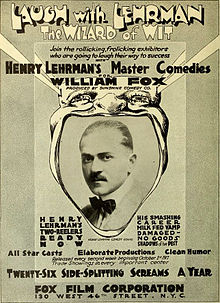Henry Lehrman
Henry Lehrman (born March 30, 1886 in Vienna , † November 7, 1946 in Los Angeles ) was an Austrian - American film actor , director , producer , production manager and screenwriter . He began his career in the United States in 1909 and was responsible for over 400 slapstick and comedy productions in his life .
Life
Emigration and entry into the film industry
Henry Lehrman attended a commercial academy in Vienna and then completed his military service as an imperial and royal lieutenant at the Przemyśl fortress . In 1908 he emigrated to the United States without knowing English, where he learned the national language in the personal contact system . He initially worked as a tram controller in New York and visited small theaters in his free time, but his artistic performance did not impress him. He now began to be interested in the scenic possibilities of the film.
In 1909 he decided to enter the film industry. In order to increase his employment chances, when he presented himself to the New York biographers' studio, he claimed that he had gained experience in France with the then world's largest film company, Pathé . David Wark Griffith , then one of the people in charge at Biograph, noticed the fraud, but still gave Lehrman a chance as an extra . In reference to the hoax, he also nicknamed Lehrman Pathé . Since Lehrman proved himself, he was also awarded the first major roles and even directing duties.
Hollywood career
1913 changed Lehrman on the recommendation of silent movie star Mabel Normand to that of Mack Sennett newly founded Keystone Production to California , where actors and extras for spoofs and slapstick films were searched. There the talented comedian Lehrman soon got bigger roles. He became Sennett's closest collaborator and rose to the position of “Top Director” of the “Comedy Unit”, that is to say the highest director in the comedy department. As such, he has now directed many one-act plays (" onereeler ") for Keystone, including Charlie Chaplin's first four films . Under Lehrman's direction, Chaplin first appeared in the role of the tramp in Kid Auto Race at Venice . However, there were difficulties working with Sennett - both directed several times together - as Lehrman preferred a fast-paced, grotesque style in slapstick films, while Sennett was more in favor of a slower rhythm. Since there were hardly any written scripts for the one-act plays, the differences of opinion had to be settled on set . Lehrman finally left Keystone in February 1914.
He then worked briefly at Universal Studios with Ford Sterling for Fred Balshofer's Sterling Comedies , but in October 1914 - as a subsidiary of Universal - he founded his own film company specializing in comedies: the L-KO Motion Picture Company (L-KO stands for Lehrman knockout). This produced around 300 high-class one-act plays and specialties in the popular style of Mack Sennett's early films. This also brought him posthumously accused film historians of simply copying Sennett's style. At the time of the L-KO productions, Sennett had already deviated from his original concept, which also meant that he lost the refreshing quality of his first productions, which Lehrman, however, knew how to secure.
After Universal, Lehrman worked briefly for Carl Laemmles IMP and Kinemacolor , until he was hired by William Fox as production manager for the Sunshine Comedies in 1917 . He also directed the Lloyd Hamilton / Virginia Rappe film series for Fox in 1918 with the titles Wild Woman and Tame Lions , A Higher Driver's Last Kiss and Twilight Baby .
Since 1919, Lehrman was in a relationship with actress Virginia Rappe . She starred in at least four of Lehrman's films: His Musical Sneeze , A Twilight Baby , Punch of the Irish and A Game Lady . In 1921, Rappe, who was now his fiancée, died at a dissolute party hosted by popular comedian Roscoe "Fatty" Arbuckle at the St. Francis Hotel in San Francisco . Lehrman made him responsible for Rappe's death as a result. A sensational press campaign and two lawsuits destroyed Arbuckle's career. James Cruze used the scandal as a template for his film Hollywood in 1923 .
In 1922 Lehrman married Jocelyn Leigh .
With the advent of talkies, Lehrman ended his career after staging around 400 short comedies and numerous film appearances.
His grave is located at the Hollywood Forever Cemetery in Hollywood, Los Angeles, in the Garden of Legends , Lot 257.
Filmography
The following is a selection from over 400 films with the participation of Henry Lehrman, with the type of participation in brackets. "S" stands for acting, "R" for direction, "sup" for supervisor and "D" for script.
|
|
literature
- Rudolf Ulrich: Austrians in Hollywood. New edition, Verlag Filmarchiv Austria, Vienna 2004, ISBN 3901932291 , pp. 288–291
Individual evidence
- ↑ "according to old American newspaper articles", information not verified; In: Rudolf Ulrich: Austrians in Hollywood. New edition, Verlag Filmarchiv Austria, Vienna 2004, p. 288
- ^ A b Rudolf Ulrich: Austrians in Hollywood. New edition, Verlag Filmarchiv Austria, Vienna 2004, p. 288
Web links
- Henry Lehrman in the Internet Movie Database (English)
- Henry Lehrman in the database of Find a Grave (English)
| personal data | |
|---|---|
| SURNAME | Lehrman, Henry |
| ALTERNATIVE NAMES | Lehrman, Henry M. |
| BRIEF DESCRIPTION | American film pioneer |
| DATE OF BIRTH | March 30, 1886 |
| PLACE OF BIRTH | Vienna |
| DATE OF DEATH | November 7, 1946 |
| Place of death | los Angeles |
